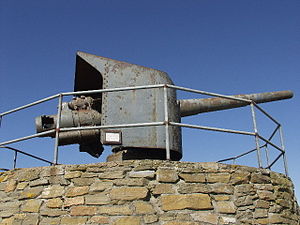Action off Lerwick
| Action off Lerwick | |||||||
|---|---|---|---|---|---|---|---|
| Part of World War I | |||||||
 Gun from SMS Bremse at Scapa Flow |
|||||||
|
|||||||
| Belligerents | |||||||
|
|
|
||||||
| Commanders and leaders | |||||||
|
|
|
||||||
| Strength | |||||||
| 2 destroyers 2 naval trawlers |
2 light cruisers | ||||||
| Casualties and losses | |||||||
| ~300 killed or wounded 2 destroyers sunk |
None | ||||||
| The British were escorting twelve merchant ships during the battle, nine were sunk. | |||||||
|
|
|||||||
The Action off Lerwick was a small naval battle of 1917 fought in the North Sea during the First World War. Two German light cruisers attacked a convoy of coal-carrying ships and their escort. In the course of the battle, the two escorting destroyers and nine neutral Scandinavian ships were sunk off Shetland, Scotland.
The British regularly shipped coal across the North Sea from Norway in 1917; these convoys were lightly defended so the Kaiserliche Marine took advantage of the situation. At first, submarines were deployed to sink the merchantmen, but after these attacks failed the German Admiral Reinhard Scheer ordered an attack with surface combatants. U-boats informed Admiral Scheer that a fleet of nine Scandinavian, one Belgian and two British steamers laden with coal were headed west from Lerwick. The two light cruisers Brummer and Bremse—each armed with four 5.9 in (150 mm) naval guns and two 3.5 in (89 mm) anti-aircraft guns—were designated to ambush to convoy which was found on 17 October, 65 mi (56 nmi; 105 km) off Lerwick. They were adapted to appear as British vessels. Over 600 officers and men made up the crews of the two warships. Escorting the convoy was two British destroyers, Mary Rose and Strongbow with two naval trawlers, HMS Elise and P. Fannon. The destroyers had complements of about 80 men and armament of three 4 in (100 mm) guns, three 2-pounders and two 21 in (530 mm) torpedo tubes. British Lieutenant Commander Charles Fox led the Allies convoy in his flagship Mary Rose, Lieutenant Commander Edward Brooke skippered Strongbow.
...
Wikipedia

